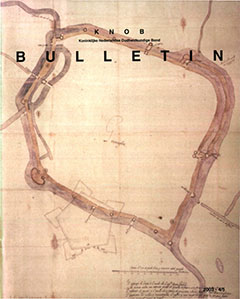Indexering ESCI / Scopus


Introductie (W. Boerefijn). Reinout Rutte m.m.v. Ko Visser en Wim Boerefijn: Stadsaanleg in de late middeleeuwen. Over bouwpercelen, straten en standaardmaten in Elburg en enige andere steden. Wim Boerefijn: Over de ideale uitleg van de stadsstraat circa 12de-16de eeuw: Misvattingen omtrent de 'renaissance' in de stedenbouw. Jaap Evert Abrahamse: Stad op papier. Visies op de zeventiende-eeuwse stadsontwikkeling van Amsterdam. Elwin Koster: De zeventiende-eeuwse stadsuitleg van Groningen: Over de keuze van de vorm en de gedachtegang van de ingenieur. Paul Burm en Guus Borger: De stichting van Friedrichstadt in 1621. Sociale segregatie in een geplande nederzetting. Lex Bosman: Stadboek en Demerara, het ontstaan van de stadsplattegrond van Geogetown (Guyana) in de achttiende eeuw.
This article deals with the layout of the new town of Elburg around 1400, the layout of some other new towns and town extensions in the Netherlands during the fourteenth century, and with the wider, international context of this town planning. For instance, there is evidence that from the twelfth to the fifteenth century a rational type of town planning and urban design were practised, both in the layout of new towns and in town extensions.
In so far as the situation allowed it, general organising principles were adopted in the planning and building of towns. Standard dimensions...
In the general historiography of town planning, there is an old and outdated idea which remains to be generally adhered to. This idea, which in essence dates from the 19th century, tells that the straight street and the orthogonal town-plan are typical aspects of 'renaissance town planning', while 'the medieval town' is thought to be an irregular but picturesque ensemble of winding streets and narrow alleys within a tightly fitting town-wall.
A very famous passage from Alberti's De re aedificatoria describes the advantages of winding streets as compared to straight...
Traditionally, large-scale and systematic building are the qualities attributed to the urban extensions of Amsterdam. The systematic character of town planning was invariably approached from new perspectives, whereby aesthetic appreciation initially prevailed.
The idea of the town as a brilliant total design dates back to the nineteenth century. This idea was presented in various forms, without being based on much substantial research. The extent to which the townscape was designed was presented as far more significant than we would now conclude from examining the facts. This is...
The article focuses on the proposition that in the military architecture of the early seventeenth century it is not only mathematics that plays an important part in the planning and layout of the fortifications. The site, the existing infrastructure and cost-reducing measures also play important and even decisive roles.
This proposition is defended on the basis of the analysis of the layout of the new fortifications around the town of Groningen as they were planned and built in the first quarter of the seventeenth century. The first part describes the planning process, the...
This article focuses on the spatial structure, the street plan and the housing blocks of Friedrichstadt in Sleeswijk-Holstein. This 'ideal new town' was founded in 1621 in the place where the rivers Treene and Eider flow together, by Remonstrants who had fled the Dutch Republic after the Synod of Dordrecht.
Besides the town plan, as it is still to be traced back in the actual layout of the settlement, the underlying deed of foundation of Friedrichstadt has also been preserved. Freedom of religion for the future population played an important part in it. But much thought was also...
The eighteenth-century establishment of Dutch towns overseas is interesting because such town-planning matters were hardly an issue in the Netherlands itself at that time. For the then colony of Demerara (Guyana) in South America J.C. Heneman made an interesting design for a small town planned some distance upstream by the river of the same name.
His starting point was the existing structure of a plantation. The design reminds you of an ideal town of Simon Stevin. Just as in other West Indian colonies under the rule of the Dutch West India Company, decision-making was utterly...


open access mogelijk gemaakt door Stichting OpenAccess
